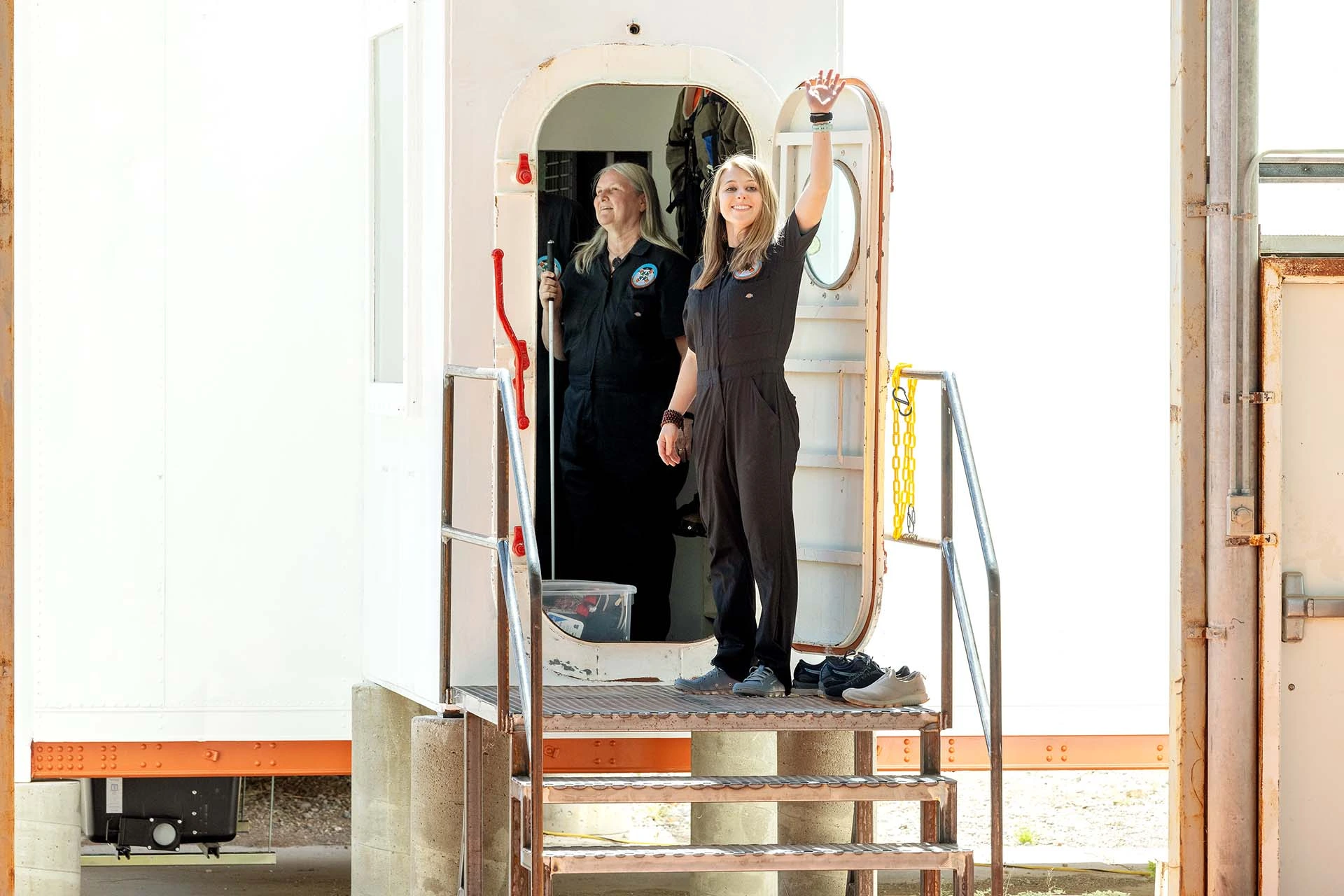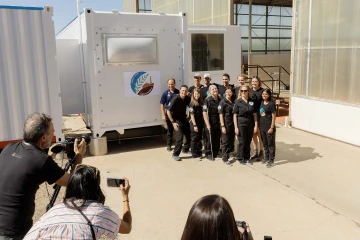Shooting For The Stars
The Inclusion I crew completes the first mission in a pressurized habitat at Biosphere 2.

Sheri Wells-Jensen and Bailey Burns, two of the four Inclusion 1 team members
Chris Richards
In April, a four-person crew sealed themselves in an air-tight, pressurized habitat on the grounds of the University of Arizona’s Biosphere 2, where eight people conducted a similar experiment more than 30 years earlier.
The Space Analog for the Moon and Mars habitat, or SAM, was created to let people experience what it might be like to live on the surface of another celestial body.
Six days after the crew members entered the habitat, a crowd gathered to watch them emerge. The crew spilled out with smiles on their faces and applause in their ears, marking the completion of SAM’s first mission, Inclusion I.
Kai Staats, director of research for SAM at Biosphere 2, and his team created SAM to serve as an experimental prototype of a fully enclosed system that might one day support humans living and working in space. Preparation for living in space requires testing the feasibility of mechanical and plant-based life support, learning to maintain food crops in a sealed greenhouse, studying the microbiome of a sealed environment, practicing using tools during extra-vehicular activity in a full pressure suit, developing a high-fi delity computer model to help design future habitats and much more.
“SAM is an analog, which is a place to practice before you do the real thing,” Staats says. “You can think of a pool as an analog — a place where you practice swimming safely before entering the ocean. In that respect, this building is an analog for how we might live on the moon and Mars. We’re practicing our techniques, procedures, technologies and even our interpersonal interactions before we eventually carry ourselves to another planetary body.”
The 1,200-square-foot SAM habitat combines the Test Module greenhouse, a Biosphere 2 prototype built in 1987, with a workshop, kitchen, common area and sleeping quarters. The Test Module greenhouse includes a hydroponic system to grow food with controlled lighting, humidity, heating and cooling. The workshop provides tools and a place to repair or build equipment for research and mission projects.
About a dozen analog space habitats exist globally, Staats says, but no others are sealed and pressurized like SAM.
The first mission
Anyone can apply to use SAM to conduct research projects. Inclusion I was the habitat’s first mission.
The crew consisted of Inclusion I mission commander Cassandra Klos, a fine art photographer and curator who visually documented the mission; mission medical officer Eiman Jahangir, a cardiologist, scuba diver, space enthusiast and two-time NASA astronaut candidate finalist; mission engineer Bailey Burns, a Blue Origin aerospace systems engineer focused on environmental control and life support systems; and mission communications and accessibility officer Sheri Wells-Jensen, a linguist who teaches at Bowling Green State University in Ohio.

Burns focused on monitoring lung pressure, oxygen and carbon dioxide levels in the habitat. Wells-Jensen helped the team consider the accessibility of the habitat. Jahangir ensured that the team stayed healthy and tested stress mitigation strategies.
From outside, Staats’ team constantly monitored the pressure, carbon dioxide, oxygen, relative humidity and temperature of the habitat. “The team had to learn how to manage the airflow to control carbon dioxide levels. Even their exercise, cooking and sleep patterns affected carbon dioxide levels,” he says. “But at no point were they close to harmful levels.”
While sealed inside, the crew members’ only means of communication with the outside world was delayed email, to simulate being far from Earth. They got creative with vegetarian freeze-dried and rehydrated ingredients to prepare meals that resembled those that would be available to lunar or Martian astronauts. They also dehydrated and stored their food scraps so future crews could feed them to mycelium — root structures that produce protein-packed mushrooms.
In addition, Wells-Jensen, who is blind, took a simulated space walk through the habitat’s prototype moon-Mars yard — a space filled with very fine basalt and rocks to mimic lunar and Martian surfaces. Since you can’t hear anything outside while wearing a pressure suit, she relied on her team to guide her through the yard by radio.
“What makes this extraordinary is that this is quite likely the first time a blind person has maneuvered across simulated Martian terrain in a pressurized space suit while breathing air through an umbilical cord drawn from a pressurized habitat,” Staats says.
Wells-Jensen also added Braille to many of the surfaces inside SAM to guide future crew members who might also be blind.
“My objective was to look at the systems and policies in terms of what would make this a welcoming space for any astronaut, regardless of their background or how their body is configured,” she said after exiting SAM. “One-quarter of the Earth has some significant disability, and we can’t leave them behind. We need everybody with us.”
Lessons from space and for Earth
Managing resources in SAM offers lessons not only for how to successfully live on the moon and other planets but also for how to live more sustainably on Earth, say those involved in the project.

For example, Inclusion I was allotted 60 gallons of water for four people over six days.
“They had to be careful with consumption, recycle as much as they could and engage in daily quality-of-water analysis as they experimented with filtration,” Staats says.
By the mission’s end, the crew had used only 40 gallons of water.
“Many of us take 40-gallon showers, let alone live with three companions for six days with that much water,” Staats says.
How we will someday live on the moon or Mars is how we should be living on Earth today, the mission participants say.
“Living within your means and living sustainability is not suffering,” Wells-Jensen says. “It doesn’t hurt you to be a good steward of the resources we were given.”
Staats and his team completed the second SAM crew and mission, Inclusion II, May 10-15. As SAM continues to grow, so will mission lengths: Eventually, missions will be months long.
